McDonnell Douglas MD-90
The McDonnell Douglas MD-90 is a single-aisle airliner developed by McDonnell Douglas from the MD-80, itself derived from the DC-9. After the more fuel-efficient IAE V2500 high-bypass turbofan was selected, Delta Air Lines became the launch customer on November 14, 1989. It first flew on February 22, 1993 and the first MD-90 was delivered to Delta in February 1995.
| MD-90 | |
|---|---|
.jpg) | |
| An MD-90 of Delta Air Lines, both its launch customer and final operator | |
| Role | Narrow-body jet airliner |
| National origin | United States |
| Manufacturer | McDonnell Douglas Boeing Commercial Airplanes |
| First flight | February 22, 1993 |
| Introduction | 1995 with Delta Air Lines |
| Retired | June 2, 2020 |
| Status | Retired |
| Primary users | Delta Air Lines (historical) Saudi Arabian Airlines (historical) Japan Airlines (historical) Scandinavian Airlines (historical) |
| Produced | 1993–2000 |
| Number built | 116[1] |
| Unit cost |
US$41.5–48.5 million |
| Developed from | McDonnell Douglas MD-80 |
| Variants | McDonnell Douglas MD-94X |
The MD-90 competed with the Airbus A320 and the Boeing 737 NG. It has a 5 ft (1.4 m) longer fuselage to seat 153 passengers in a mixed configuration over up to 2,455 nmi (4,547 km), it kept the MD-88 electronic flight instrument system (EFIS). The shorter MD-95 was renamed the Boeing 717 after McDonnell Douglas merged with Boeing in 1997. Production ended in 2000 after 116 deliveries. Delta Air Lines flew the final commercial flight on June 2, 2020.
Design and development
Background
The Douglas Aircraft Company developed the DC-9 in the 1960s as a short-range companion to their larger DC-8.[2] The DC-9 was an all-new design, using two rear fuselage-mounted turbofan engines, and a T-tail. The DC-9 has a narrow-body fuselage design with a 5-abreast seating with a capacity of 80 to 135 passengers depending on seating arrangement and aircraft version.
The second generation of the DC-9 was originally called the DC-9-80 series or the DC-9 Super 80, but it was later marketed as the MD-80[3] and entered service in 1980. McDonnell Douglas began studies into shorter derivatives of the MD-80 in 1983, these studies eventually becoming known as the MD-90. For several years, McDonnell Douglas proposed powering the MD-90 with two propfan engines,[4] such as the General Electric GE36 and the Pratt & Whitney/Allison 578-DX. By mid-1989, it was clear that there was insufficient interest in propfan-powered aircraft, so the company reworked its proposals to instead feature the IAE V2500 turbofan,[5][6] which was estimated to be $1 million cheaper than the GE36 and had already been certificated for the Airbus A320.[7] Within six weeks of eliminating the propfan option, the MD-90 secured a large launch order.[8]
MD-90
The MD-90 was firmly launched on November 14, 1989, when Delta Air Lines placed an order for 50 MD-90s, with options for a further 110 aircraft.[5][9] The aircraft first flew on February 22, 1993 and the first MD-90 was delivered to Delta in February 1995.[10] The MD-90 was produced adjacent to the Long Beach Airport in Long Beach, California, USA.
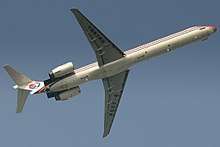
The MD-90 is a mid-size, medium-range airliner that was developed from the MD-80 series. Resembling the preliminary version of the MD-88 from March 1984,[11] the MD-90 is a 57-inch-longer (1.4 m), updated version of the base MD-80 with similar electronic flight instrument system (EFIS) and more powerful, quieter and fuel efficient IAE V2500 engines instead of the JT8D engines, which power the MD-80 series.[12] This made the MD-90 the first derivative variant of the DC-9 to use a high-bypass turbofan engine. Due to the heavier engines, the engine pylons feature flaps that deflect 30° downward to assist in pitching down for stall recovery. The system activates automatically when the control column is pushed fully forward.[13]
Typical seating for the MD-90 ranges from 153 to 172 passengers, depending on the cabin configuration and interior layout.[14] The MD-90 was produced in two versions: -30 and -30ER. The -30 has a range of 2,045 nmi (3,787 km). The -30ER has a higher gross weight and range up to 2,455 nmi (4,547 km) with an extra 565 US gal (2,140 L) auxiliary fuel tank.[15] An even longer-range version, the -50, was offered but was never ordered.[16]
The initial MD-90s feature an EFIS cockpit similar to the MD-88's cockpit.[17] The 29 MD-90s delivered to Saudi Arabian Airlines feature a full glass cockpit with avionics and an overhead display panel similar to the MD-11's cockpit for easy transition for the airline's pilots of the MD-11, also operated by the airline.[17][18]
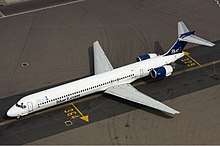
No MD-90 orders were received after Boeing and McDonnell Douglas merged in 1997 due to internal competition with Boeing's 737.[19] Delta Air Lines had initially placed a large order for the MD-90 to replace some aging Boeing 727s. After the Boeing-McDonnell Douglas merger, Delta canceled their remaining 19 MD-90 orders in favor of the Boeing 737-800.[19][20] A total of 40 MD-90s (later 20) were to be assembled under contract in Shanghai, People's Republic of China under the Trunkliner program,[21][22] but Boeing's decision to phase out the MD-90 resulted in only two built by Shanghai Aircraft.[23]
MD-90 production at Long Beach, California ended in 2000 with the last airplane being delivered to Saudi Arabian Airlines,[19] and MD-90T production at Shanghai ended in 2000. With 116 MD-90 aircraft produced, the MD-90 production run was the smallest among the DC-9 family.[1] Two aircraft were also produced at Jiangwan Airfield in Shanghai, People's Republic of China.[24]
Following the MD-90 in the DC-9 family was the MD-95, which was renamed the Boeing 717-200 after McDonnell Douglas (successor to Douglas Aircraft Company) merged with Boeing in 1997.[25] The main competitors of the MD-90 included the Airbus A320 and the Boeing 737-800.
Variants
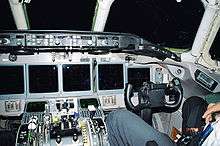
- MD-90-10
- A shorter variant with the same length as the MD-87, carrying from 114 passengers in a three-class layout to 139 passengers in a high-density configuration. It has a maximum takeoff weight (MTOW) of 69.49 short tons (63.04 t; 138,980 lb; 63,040 kg) and a range of 2,410 nmi (2,780 mi; 4,470 km) with fuel reserves.[26] Engine thrust would be 22,000 lbf (99 kN).[27] This variant was not built.
- MD-90-10EC
- Unbuilt "European Community" version of the MD-90-10, with a higher MTOW and the engine thrust raised to MD-90-30 levels for an increased range of 3,000 nmi (3,450 mi; 5,550 km).[28]
- MD-90-20
- Retrofit of MD-80 series aircraft to V2500 engines.
- MD-90-30
- Base variant with two V2525-D5 engines and an EFIS cockpit similar to that of the MD-88. This engine also has an option to add 3,000 lbf for use in Hot & High conditions if needed by activating a switch in the flight deck.
- MD-90-30EC
- Unbuilt "European Community" version of the MD-90-30, with a higher MTOW and the engine thrust raised to MD-90-40 levels for an increased range of 2,800 nmi (3,220 mi; 5,180 km).[28]
- MD-90-30IGW
- Increased Gross Weight version, one built.
- MD-90-30ER
- Extended Range (ER) version of MD-90-30, two built.
- MD-90-30T "Trunkliner"
- Variant of the MD-90-30 assembled by Shanghai Aviation Industrial Corporation in the People's Republic of China. Production was initially planned to be 40,[29] later reduced to 20,[30] with only two built in the end.[31] To accommodate the heavy aircraft on unsuitable runways, a dual tandem landing gear with more tires to spread the weight of the aircraft was designed for the Trunkliner,[32] but ultimately not used in the two aircraft produced.[33] The Comac ARJ21 is built using tooling retained by the Chinese after the end of the Chinese MD-90-30 program.[34]
- MD-90-30EFD
- Enhanced Flight Deck version of MD-90 with the same cockpit as MD-95/B717 and MD-11, 28 built.
- MD-90-40
- A proposed 172 ft long (52.3 m) variant with a maximum capacity of up to 217 passengers, though the normal three-class layout would hold 170–180 passengers. The derivative would have a storage capacity of 1,610 cu ft (45.6 m3), a maximum takeoff weight of 81.74 short tons (74.15 t; 163,470 lb; 74,150 kg), and a height of 31 ft (9.4 m).[26] Engine thrust would be 28,000 lbf (126 kN).[27] This variant was never built.
- MD-90-40EC
- Unbuilt "European Community" version of the MD-90-40, with a higher MTOW for an increased range of 1,910 nmi (2,190 mi; 3,530 km). Other improvements include wing area enlargement/strengthening, adoption of MD-11 avionics, one-person baggage loading improvements, and better interiors.[28]
- MD-90-50ER
- A proposed variant similar to the MD-90-30, but with two extra auxiliary fuel tanks mounted on the belly. The aircraft had an MTOW of 86.3 short tons (78.2 t; 172,500 lb; 78,200 kg), used IAE V2528 engines with 28,000 lbf (120 kN) thrust, and had an estimated range of 3,022 nmi (3,478 mi; 5,597 km).[33]
- MD-90-55
- A proposed variant with two extra passenger doors and room for 187 passengers in a single-class configuration.[33]
Operators
Delta Air Lines was the last remaining operator in 2020.[35] Delta began phasing out its MD-90s in 2017,[36] before retiring its remaining MD-90s after their final flights on June 2, 2020.[37]
Accidents and incidents
As of May 2018, the MD-90 has been involved in three incidents,[38] including one hull-loss accident,[38] with 1 fatality.[39]
- Notable accidents and incidents
- On August 24, 1999, Uni Air Flight 873, a MD-90, caught fire after a passenger's carry-on luggage containing gasoline was ignited by a motorcycle battery contained in another passenger's carry-on luggage. 27 people were injured with one fatality as a result of the cabin fire. The aircraft was damaged beyond economic repair.[40][41]
Specifications
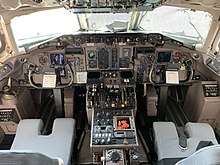
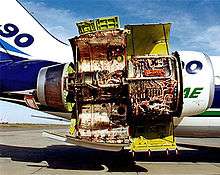
| Variant[15] | MD-90-30 | MD-90-30ER |
|---|---|---|
| Seating, 2–class | 153-158: 12J@36" + 141/146Y@31-33" | |
| Seating, 1–class | 163-172Y@29-33" | |
| Cargo | 1,300 cu ft (36.8 m3) | 1,177 cu ft (33.3 m3) |
| Length | 152.6 ft (46.51 m) | |
| Fuselage | 131.6×142 in (334.3×360.7 cm) width × height[42] | |
| Wingspan | 107.8 ft (32.86 m) | |
| Height | 30.6 ft (9.33 m) | |
| MTOW | 156,000 lb (70,760 kg) | 166,000 lb (75,296 kg) |
| Empty weight | 88,200 lb (40,007 kg) | 88,400 lb (40,098 kg)[lower-alpha 1] |
| Max. payload | 41,800 lb (18,960 kg) | 43,600 lb (19,777 kg) |
| Fuel capacity | 39,128 lb (17,748 kg)[lower-alpha 2] | |
| Turbofan engines (2×) | IAE V2525-D5 | |
| Unit thrust | 25,000 lbf (111.21 kN)[lower-alpha 3] | |
| VMO | Mach 0.84 (506 kn; 937 km/h) at 27,240 ft (8,303 m)[43] | |
| Cruise speed | Mach 0.76 (438 kn; 812 km/h) at 34,777 ft (10,600 m)[44][45] | |
| Ceiling | 37,000 ft (11,278 m)[43] | |
| Range, 153 pax | 2,045 nmi (3,787 km) | 2,237 nmi (4,143 km)[lower-alpha 4] |
| Takeoff runway | 7,000 ft (2,134 m) at 156,000 lb, ISA, SL[42] | |
- with aux fuel tank: 89,188 lb (40,455 kg)
- with aux fuel tank: 42,913 lb (19,465 kg)
- Option: 28,000 lbf (124.55 kN) V2528-D5
- 2,455 nmi (4,547 km) with extra 565 US gal (2,140 L) auxiliary fuel tank
See also
Related development
Aircraft of comparable role, configuration and era
Related lists
References
- "Boeing: Commercial - Orders & Deliveries". Boeing. Retrieved 27 July 2015.
- Norris, Guy and Wagner, Mark. Douglas Jetliners. MBI Publishing, 1999. ISBN 0-7603-0676-1.
- History - Chronology - 1977-1982 Archived March 5, 2012, at the Wayback Machine. The Boeing Company. Retrieved 2007-12-14.
- Adelson, Andrea (February 10, 1988). "Betting Big on a New Type of Jet Engine". New York Times. p. D8.
- Swanborough 1993, p.90.
- "McDonnell Douglas Drops $100 Million Prop-Fan Jet Engine". Long Beach, California, USA: Associated Press. October 11, 1989.
- "New assembly line for MD-90 Series" (PDF). Flight International. 24 June 1989.
- United States Environmental Protection Agency (EPA) (August 1990). Preliminary technology cost estimates of measures available to reduce U.S. greenhouse gas emissions by 2010 (Report). Attachment D: Memo from Michael Kavanaugh on UDF aircraft engine (PDF pages 125–134).
- Dallos, Robert E.; Vartabedian, Ralph (November 15, 1989). "Delta Places $10-Billion Order for 260 Jetliners: Aviation: The airline will buy Douglas MD-90s and Boeing 737s. Long Beach firm now has a huge backlog". Los Angeles Times. New York, New York and Long Beach, California, USA.
- "Boeing: Commercial Airplanes - MD-90 Background". Archived from the original on 2013-02-16. Retrieved 16 July 2015.
- Dixon, Michael (March 16, 1984). "McDonnell-Douglas studying MD-80 airliner derivative". Financial Times.
- Kressly, Arthur E.; Parker, Anthony C. (1995). "Development of the McDonnell Douglas MD-90". Section 1: Journal of aerospace. SAE Transactions. 104. pp. 1612–1623. doi:10.4271/952052. JSTOR 44612076.
- "Powerfully quiet" (PDF). Flight International. 26 October - 1 November 1994: 37.
- "Boeing: Commercial Airplanes - MD-90 Technical Characteristics". Archived from the original on 2013-03-08. Retrieved 16 July 2015.
- "MD-90" (PDF). Startup. Boeing. June 1, 2007.
- MD-90 page, airliners.net. Retrieved 2008-12-08. Archived 2008-03-11 at the Wayback Machine
- Becher 2002, p. 105.
- Saudia Calls for Honeywell Flat Panel Cockpit Displays for New MD-90s Archived 2008-07-27 at the Wayback Machine. Honeywell. February 6, 1996. Retrieved: 2008-12-08.
- Becher 2002, pp. 102-105.
- Delta's 1997 Annual Report, Delta Air Lines. Retrieved 2008-12-08.
- China Northern Airlines Receives First MD-90 Aircraft, The Boeing Company. Retrieved 2008-12-08. Archived 2008-04-18 at the Wayback Machine
- "Cox Report - May 25, 1999". cnn.com.
- Boeing in China, The Boeing Company. Retrieved 2008-12-08. Archived 2008-10-20 at the Wayback Machine
- Shanghai Jiangwan Airfield. Global Security. Retrieved: 2008-12-09.
- Boeing Chronology, 1997-2001 Archived January 2, 2013, at the Wayback Machine, Boeing
- "MD-90 family will include 180-seater 40 variant" (PDF). Technical: Air Transport. Flight International. December 12, 1989. p. 16.
- "Commercial aircraft of the world". Flight International. September 4–10, 1991. p. 62.
- Postlethwaite, Alan (February 21–27, 1990). "Europe offered new variant of MD-90" (PDF). Flight International.
- Mintz, J., Sale of Aircraft Machinery to China Shows Perils of Exporting Technology, Washington Post, June 7, 1998. Retrieved 2008-12-09.
- "China Northern Airlines Receives First MD-90" (Press release). McDonnell Douglas Corporation. July 26, 1996. Archived from the original on December 17, 2000.
- Becher 2002, p. 104.
- Bailey, J., "China: Boeing argues MDC lead". Flight International, May 1–7, 1991. Retrieved 2008-12-09.
- Forecast International (May 2002). Civil aircraft forecast: Boeing MD-80/90 Series - archived 5/2003 (PDF) (Report). p. 4. Archived from the original on February 26, 2009.
- Burchell, Bill. "Setting Up Support For Future Regional Jets". Aviation Week, October 13, 2010.
- "Delta Air Lines Fleet Details and History". planespotters.net. Retrieved June 1, 2020.
- Russell, Edward (2018-07-13). "Delta pulls newer MD-90s over MD-88s in fleet update". Flightglobal.com. Retrieved 2019-01-23.
- Staff writer (June 1, 2020). "By the numbers: A final salute to Delta's MD-88 and MD-90 'Mad Dogs'" (Press release). Delta Air Lines. Retrieved June 1, 2020.
- McDonnell Douglas MD-90 incidents. Aviation-Safety.net, May 25, 2018.
- McDonnell Douglas MD-90 Accident Statistics. Aviation-Safety.net, May 25, 2018.
- MD-90 UNI Air accident on August 24, 1999. Aviation-Safety.net. Retrieved: August 9, 2010.
- "Accident Investigation Report UIA 873, B-17912MD-90-30 cabin explosion and fire during landing roll Hua-Lien, Taiwan" (PDF). August 24, 2000. Archived (PDF) from the original on September 24, 2015. Retrieved August 14, 2014.
- "MD-90-30 airplane characteristics for airport planning" (PDF). Boeing. Oct 2002.
- "Type Certificate Data Sheet" (PDF). FAA. March 25, 2014.
- John Bailey (6 December 1989). "Douglas uses MD-80 to speed MD-90". Flight International.
- Kane, Robert M. (2003). Air Transportation: 1903–2003 (14th ed.). pp. 586–588. ISBN 0-7872-8881-0. LCCN 2002105811. OCLC 50695027.
- Becher, Thomas. Douglas Twinjets, DC-9, MD-80, MD-90 and Boeing 717. The Crowood Press, 2002. ISBN 1-86126-446-1.
- Swanborough, Gordon. "A 'Ninety for the 'Nineties". Air International, August 1993, Vol 45 No 2. Stamford, UK:Key Publishing. pp. 90–95
- Norris, Guy (June 9–15, 1993). "Smooth operator". Flight International. Photographs by Mark Wagner. Cutaway drawing by John Marsden. pp. 45–48, 50.